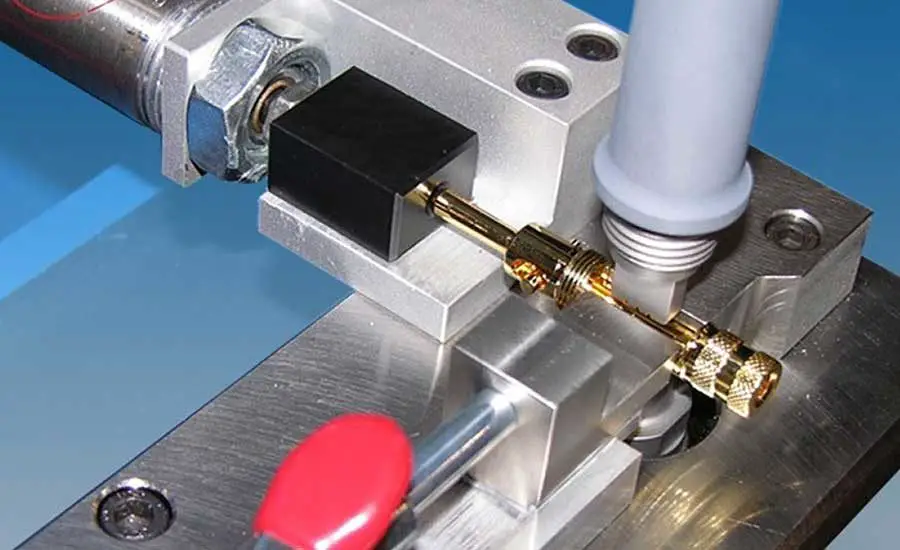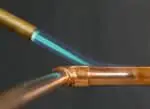Ultrasonic welding, also known as a modern welding technique for metals and plastics, is one of the most widely utilised welding processes in the industry.
When it comes to joining two moulded plastic pieces, ultrasonic welding is the best option. It is an effective method of fusing thermoplastic components by utilising the energy of high-frequency, low-amplitude acoustic vibrations.
It is quick, inexpensive, easily automated, and ideally suited for mass manufacturing, with high production rates achievable.
Ultrasonic energy is insufficient to build massive joints longer than 250 mm. The transducer’s power output is insufficient to handle anything greater. So the minimum thickness that can be welded using the ultrasonic welding technique is 0.38mm.
Because thick materials cannot be easily vibrated using mechanical vibration energy, ultrasonic vibration is an inadequate welding process for thicker materials.
Unlike friction or vibration welding techniques, in which one of the two pieces is moved to create friction, ultrasonic welding generates friction from acoustic energy, which generates heat and welds the two parts on a molecular level. The entire procedure may be completed in a matter of seconds.
The working of Ultrasonic Welding
A high frequency ultrasonic vibration (20 kHz to 40 kHz) is used to connect two plastic parts together. The high-frequency vibration creates heat energy and melts the material at the contact of the two parts. When the molten material cools and solidifies, it bonds with each other to produce a strong weld.
The most common frequencies are 15, 20, 30, 35, or 40 kHz.
Main components of Ultrasonic Welding.
The following are the several key sections or components of ultrasonic welding:
1.) Press- A press is used to provide pressure to the two plastic parts that will be connected. It might be pneumatic or electrically powered.
2.) Nest, Anvil, or Fixture- A clamping mechanism used to hold and clamp the two plastic components together. It enables high-frequency vibration to be directed to the interface between the two parts.
3.) A Stack of Ultrasonics- It is made up of three parts: a converter (or piezoelectric transducer), a booster, and a sonotrode.
-
-
- Converter- It turns electrical impulses into high-frequency mechanical vibration. It does this through the piezoelectric action.
- Booster- It mechanically adjusts the amplitude of vibration. It is used to clamp the stack in the press in various standard systems.
- Sonotrode- It vibrates at a high frequency and delivers mechanical vibration to the two components to be welded.
-
4.) Ultrasonic Generator- An ultrasonic generator creates and transmits high-frequency electrical impulses that correspond to the stack’s resonance frequency.
5.) Controller- It is utilised to regulate the movement of the press as well as the delivery of ultrasonic energy.
Here is a video of how ultrasonic welding works-
What is the process through which Ultrasonic Welding melts materials?
Ultrasonic welding provides modest yet quick vibrations. When the horn or sonotrode is attached to materials, the ultrasonic vibrations cause the materials to move in a to and fro motion of roughly half a millimetre.
Because the rate of vibration is relatively high, such a small movement is sufficient to melt the material. These vibrations force the materials to rub against one other, generating heat as a result of the friction.
The friction raises the temperature to the point where the contact sites between the materials melt, allowing molecular bonding to occur. This is how ultrasonic welding joins two pieces of plastic.
When it comes to welding metals, however, there is a tiny distinction. The metal is heated to one-third of its melting point temperature using ultrasonic welding.
The molecules between the two metals will now pass across each other, forming a strong chemical connection. Metals have no melting points.
Advantages of Ultrasonic Welding
Because of its versatility to be utilised on thermoplastics and other materials, ultrasonic welding has gained great favour across a variety of sectors.
Some of the benefits of ultrasonic welding are discussed further below:
1.) Weld Quality- Ultrasonic welding results in an extremely clean and exact joint. It creates no plastic flash or distortion when used properly, resulting in a clean, practically undetectable seam that requires no touch-up work.
2.) Safety- When compared to other welding procedures, using ultrasonic welding equipment is exceptionally safe. The ultrasonic energy is precisely focused, lowering the possibility of risks caused by surplus electrical energy.
Moreover, the heat created is low, confined, and quickly dispersed, decreasing the thermal impact on the material and the possibility of excess heat injuring any adjacent equipment.
3.) Speed- One of the most notable advantages of ultrasonic welding is that it is a lightning-fast procedure. The transmission of high-frequency ultrasonic acoustic vibrations through the horn allows the material to swiftly heat, weld, and cool.
In many situations, the welding process is completed in a matter of seconds, providing for great throughput and quick turnaround times.
4.) Reliability- Once installed and verified, ultrasonic welding equipment is extremely reliable. The procedure can even be automated so that thousands of components can be welded consistently with minimum human interaction.
As a result of this dependability, equipment breakdowns and bad welds are of minor concern.
5.) Versatile- Ultrasonic welding is versatile since it may be used on a wide range of materials and components. This method may be used to join thermoplastics and metals, and it is especially beneficial for joining different materials like plastics.
6.) Reduced Material Costs- In terms of material utilisation, the ultrasonic welding technique is particularly cost-effective. Because the procedure does not employ connective bolts, solder, or adhesive material, it helps to cut project material expenses.
Disadvantages of Ultrasonic Welding
1.) It can’t be utilised to make massive joints (greater than 250 x 300 mm).
2.) It necessitates carefully constructed joints to allow tip contact during the welding operation.
3.) Ultrasonic welding is an excellent method for sealing or welding polymers. However, not all polymers are weldable.
4.) Plastics, like metals, come in a variety of forms. It is critical to guarantee that the polymers to be welded are chemically compatible.
5.) Another thing to bear in mind while ultrasonic welding any material is to ensure a consistent contact area.
Applications of Ultrasonic Welding:
This technique has a wide range of applications in a variety of sectors, notably for small, fragile, or complicated components:
1.) Electrical/Computer industry- Microcircuits, computer discs, flash drives, wired connectors, field coils, and capacitors.
2.) Automotive and Aerospace Industry- Instrument panels, steering wheels, air ducts, interior door panels, and engine components.
3.) Medical Industry- Medical textiles include hospital gowns, face masks, and other sterile clothes, as well as blood/gas filters, dialysis tubing, cardiometry reservoirs, IV catheters and filters, and heart sensors for bypass patients.
4.) Consumer Goods and Packaging- Blister packs, wrappers for candy bars, frozen food packages, containers for liquids such as milk or juice, and containers for hazardous or heat-sensitive products such as ammunition or explosives. Even toys and tools.
How does Ultrasonic Welding work?
Here is a step by step on how this welding technique works-
1.) The horn is designed to make touch with the upper half of the piece.
2.) Then the two components are pressed together against the fastening. The pressure is applied using an electric-powered press.
3.) The mechanical vibration is transmitted to the two plastic parts by vibrating the horn vertically at very high frequency- 20 kHz to 40 kHz. This creates heat energy at the point of contact between the two surfaces, melting them.
4.) On cooling and solidification, a clamping force is applied to the two components for a predefined period of time to fuse them together and make a strong weld.
5.) The clamping force is eliminated and the horn is withdrawn after solidification. The welded plastic portion is removed from the fixture as a single piece.
Conclusion
Ultrasonic welding provides both quality and cost reductions. It does have various advantages if you want to employ it, but it has certain limitations too.
Like you cannot weld thick metals with ultrasonic welding technique but you can weld the thinnest of metals using this technique.
However, when working with ultrasonic welding, you’ll need an expert maintenance service to keep your ultrasonic welding equipment going properly for a long duration.








